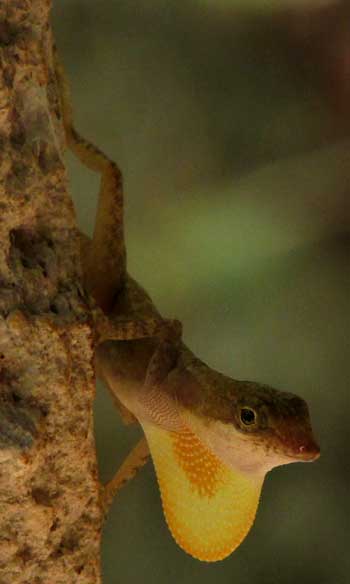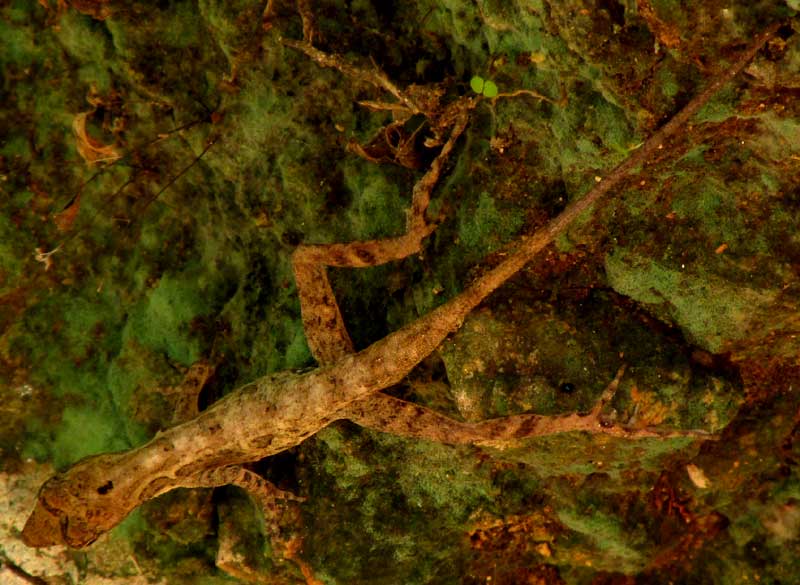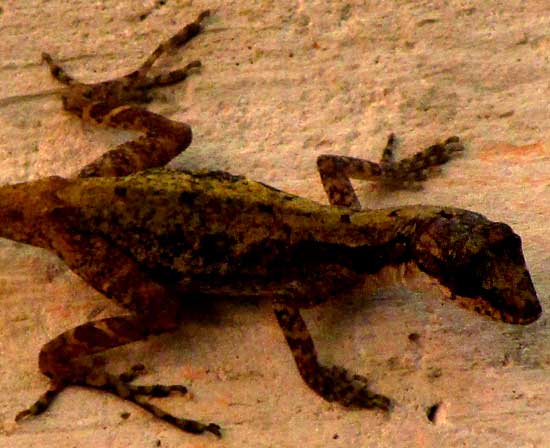Excerpts from Jim Conrad's
Naturalist Newsletter
from the June 14, 2018 Newsletter issued from Rancho Regenesis in the woods ±4kms west of Ek Balam Ruins, central Yucatán, MÉXICO
ANOLE ON THE PORCH
While I sat on the hut's porch reading, movement to my right caught my eye. It was the little whitish anole that often comes sits with me, looking around for unalert flies. I'd been assuming that my visitor was an especially pale form of the Brown Anole that had been so common in my hut back at Chichén Itzá, but then something unexpected happened, shown below:

That extended yellow dewlap with an orangish blotch was something I hadn't seen on Brown Anoles. A little delving into the matter turned up the information that such dewlaps might appear on a female Silky Anole, or maybe an immature male one. Silky Anoles sometimes are called Blue-spot Anoles, but the Reptile-Database web page for the species calls them Silkies, so I'll go with that. They are ANOLIS SERICEUS*. The dewlaps on mature males may have conspicuous blue blotches in their centers.
*UPDATE: In 2024 when I upload the pictures on this page to iNaturalist, user "pedro_nahuat," an active and published herpetologist, recognized this as Rodriguez's Anole, ANOLIS RODRIGUEZII. This species occurs throughout the Yucatan Peninsula and the southern Mexican and northern Guatemalan and Honduras lowlands.
Also in 2024, with much more information on the Internet, I find that M. Álvarez del Toro & H.M. Smith in their 1956 study "Notulae herpetologicae Chiapasiae wrote that this taxon differs from others in its group "... in having the combination of exceedingly small head scales, especially in frontal depression across the middle of which are counted 7 longitudinal rows between semicircles; scales of upper foreleg exceedingly small (smaller than ventrals, larger than middorsals); middorsal scales virtually not at all enlarged as compared with lateral dorsals; 5-7 enlarged supraoculars, the innermost row consisting of 3 large scales each with a diameter equal to at least half width of supraocular area from semicircles to lateral edge."
These details suggest that to recognize this species you must pay attention to subtle details unknown to me in 2018.
from the June 28, 2018 Newsletter issued from Rancho Regenesis in the woods ±4kms west of Ek Balam Ruins, central Yucatán, MÉXICO
A DIFFERENT LOOKING ONE
This week either the same individual pictured above, who'd changed colors, or a different one turned up. It's important to be familiar with the variations, so below you can see two views of a different look, the first one showing the visitor perched on the near-vertical side of the deep pit below the porch:

A second view:
